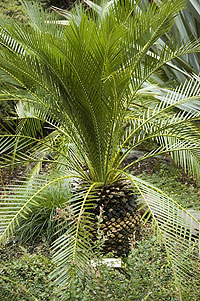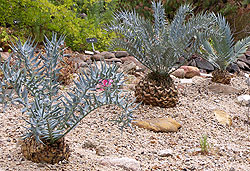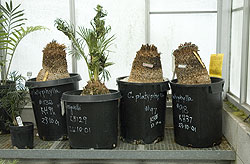Berkeleyan
 |
Horticulturist Judith Finn displays the female cone of Burrawang cycad (Macrozamia communis), a native of New South Wales, Australia. In the garden since 1961, it is No. 84 in the garden's tour of waterwise plants and is planted in the Cycad and Palm section.(Peg Skorpinski photo) |
 View slide show: Tribe of ancients View slide show: Tribe of ancients |
Tribe of ancients
From prehistoric predators to modern poachers, the UC Botanical Garden's cycad species have seen it all
![]()
| 01 February 2007
Kiss off Survivor: Borneo. Forget the last man standing from tribes of strangers marooned in Palau, Panama, Guatemala, or Thailand. Here among us, just up Centennial Drive, is the real deal, a troupe of survivors with genuine gravitas: the cycads.
Inhabitants of Earth since the Permian Age, about 100 million years before dinosaurs got started, cycads are unusual-looking plants resembling a cross between fern and palm, though in reality they're more closely related to conifers. Over the course of 250 million years the cycad tribe has lost many species to extinction. But hundreds more have managed to endure - despite predators, disease, climate change, natural disasters, and the recent, devastating troubles visited upon them by humankind.
 Macrozamia moorei, above, can grow the tallest stem of all Macrozamia species, up to seven meters, in its native habitat, Queensland, Australia. Not at conservation risk, it's found in the garden's Australasian area. (Deborah Stalford photo) |
Today, cycads are native to tropical and subtropical habitats on five continents. That said, there are few better places in the world to commune with cycads than the UC Botanical Garden, where horticulturists have recently been planting scores of rare specimens among the "arid exotica" on the entrance plaza and in other hospitable locations throughout the grounds.
"Cycad specialists, when they look at what we have, can't believe it," says garden director Paul Licht, who counts nearly 700 cycads from 123 taxa - some of them extremely rare and endangered in the wild - in the garden's "living museum," and who recently approved the decision to daylight scores of cycad specimens for public appreciation. The UC Botanical Garden has had cycads in its collection since at least 1950. But their numbers grew exponentially this decade, after undercover agents of the U.S. Fish and Wildlife Service, in mid-2001, closed in on an illegal smuggling operation, arresting key players and confiscating close to a thousand cycads brought into the U.S. from southern latitudes.
The story behind Operation Botany, the agency's first big plant sting, was the subject of a New York Times Magazine article, "The Cult of the Cycads," in August 2005. What couldn't be said in print at the time was where all those marooned and manhandled plants now reside. The UC Botanical Garden has long served as a repository for illegally imported plants, and it was here that the cycads found safe harbor following the sting.
Horticulturist Judith Finn and a crew of garden staff and volunteers went to an East Bay warehouse in 2002 to retrieve the confiscated cycads, and the sight that awaited them inside its doors is permanently etched in Finn's brain. "I almost had a heart attack," she recalls. "They looked awful."
 The Encephalartos horridus specimens above were recently planted in the botanical garden's Southern Africa area. (Courtesy UC Botanical Garden) |
But cycads are no wusses. About 700 rugged individuals survived, although many opted to lay low for two, three, four years - dormant (and butt-ugly) in their pots - refusing to put out cones or leaves. Many cycads have a life expectancy of hundreds of years, Finn explains. "They grow slowly. They're patient. They can sit in a pot for three years and do 'nothing' - and then come to life again."
Charged with aiding the cycads' recovery, she's done just that (with great skill and patience, garden colleagues say): monitoring the progress of individual plants; worrying about every spot of disease and applying fungicide as needed; collecting and freezing pollen from male plants for future hand-pollination of a female cycad of the same species; waiting years, at times, for the first, thrilling sign of a new cone, which cycads use to reproduce.
"You nurse them. You buy into the idea that their life is important," says Finn, who retired in early January after a 30-year career at the garden. Horticulturist Meghan Ray now cares for the cycad collection, though Finn will continue to be involved as a volunteer, along with her friend and cycad mentor, retired scientist Tim Gregory.
 These Cycas platyphylla, native to northern Queensland, Australia, did not fare well during their illegal importation. Finn waited four years for one of them to send up new leaves; hope is still alive that the others will too, in their own good time. (Deborah Stalford photo) |
For many years the horticulturist in charge of the garden's carnivorous-plant collection (a tropical pitcher-plant hybrid, Nepenthes Judith Finn, bears her name) before she assumed responsibility for the cycads, Finn considers it an honor to tend these living fossils. "Cycads are plants that have truly been magnificent and have lived through all sorts of terrible problems," she says. "And then man comes along and in his greed just takes them - not for survival but because someone will pay a lot of money for them. That's really, really low. If I can help to preserve them, I certainly will."
Indeed, preservation of individual cycads, and conservation of entire species, is a responsibility the garden takes seriously. According to Chris Carmichael, associate director of collections and horticulture, the garden is working with other major botanical institutions - both in the U.S. and in South Africa, where many of the confiscated cycads originated - to devise and execute a conservation plan.
"It becomes complex because in South Africa there's a highly organized black market, and South African biologists are very worried about the situation," Carmichael explains. "People use helicopters to fly in to harvest these things. Nowhere is safe."
Until the security situation stabilizes, says Carmichael, botanists on both continents have agreed that the best way forward is for the UC Botanical Garden to "propagate the ultra-rare cycads and send propagules back to South Africa, where they reintroduce them into the wild. That way, hopefully, the wild populations won't be under such intense assault."

